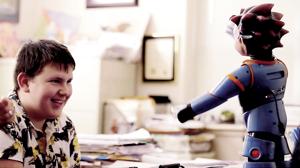Posted: Wednesday, November 15, 2017 6:00 am
By JAY CORDRAY
Autism spectrum disorder (ASD) is a developmental disability that can cause significant social, communication and behavioral challenges. The term “spectrum” refers to the wide range of symptoms, skills and levels of impairment exhibited by people with ASD.
The Centers for Disease Control and Prevention (CDC) estimates that one in 68 children in the United States have been identified with ASD. According to Morgan Local School District (MLSD) Special Programs Director Bev Steinbrecher, there are at least 15 students diagnosed with ASD in this district.
Most children with ASD have limited ability to communicate and interact with others. They may have difficulty developing language skills, understanding what others say to them and often have difficulty recognizing forms of nonverbal communication such as hand gestures, eye contact and facial expressions. These difficulties severely affect their ability to interact with others, especially people their own age.
MLSD now has a new tool to help children with ASD practice their communication and social skills, Milo the robot, from Robots4Autism. People with autism typically don’t like to look at people, but love technology. Milo is designed to be interesting and approachable for children with ASD.
Milo stands about two and a half feet tall and looks like a little kid in a space suit. He can walk, talk and even replicate human facial expressions. Milo’s face is made of a soft rubber. Underneath the rubber are several different actuators that allow his eyebrows to raise and lower, his eyes to open and shut and his mouth to mimic smiles and frowns. His nose even scrunches up when he smiles, just like a real little kid.
“Milo’s movements and expressions are slightly exaggerated,” Steinbrecher said, “so the kids can better pick up things like facial expressions and their meanings.”
Milo delivers lessons verbally. As he speaks, symbols are displayed on a screen in the center of his chest to help students better understand what he is saying. Steinbrecher said children with autism tend to think in pictures, rather than with words, so seeing images on Milo’s chest screen helps focus their attention on the lessons.
Throughout the lessons, Milo asks the students to watch short video clips on a tablet. The videos show other children displaying the skills or behaviors that Milo is teaching both correctly and incorrectly. Students are then asked “yes” or “no” questions to determine if the children in the video are doing the behaviors right or wrong.
Students work with Milo, along with an educator or therapist, for 30 minutes, three times a week. Steinbrecher began working with students and Milo last week. The first course was an introductory lesson where students directed Milo what to do. She described one little girl’s interaction with Milo.
“It’s interactive. They played Follow The Leader, so she was in charge of telling him what to do,” Steinbrecher said, “She would press Dance Party on the tablet, because she liked the Dance Party, and Milo would dance for her. She would get to choose again whatever she wanted him to do, and he would do whatever she told him to do. She just thought that was great.”
The lessons are designed to teach social behaviors and emotional identification to learners from ages five to 17 who meet the prerequisite skills, including being able to answer yes or no questions and possessing the needed motor control to operate the tablet that permits them to respond to Milo’s queries.
Studies have found that the attention of children with autism is typically engaged about three percent of the time. In children who have worked with Milo, that number jumps anywhere from 18 to 85 percent of the time.
“One of the first lessons they work on is how to calm down,” Steinbrecher said. “A lot of kids with autism get upset easily because they don’t understand a social situation. This teaches them a couple different ways they can calm down. And, as the facilitator, I can go back to them strategically at any time during the course.”
Steinbrecher stressed that Milo is in no way intended to replace teachers, but rather he is just one more tool that teachers have to help them work with students.
“A lot of our teacher prep programs don’t prepare teachers to teach social skills,” Steinbrecher said. “Social skills are something most people take for granted, especially if you don’t know someone who is affected by ASD.”
Though it is unknown for sure how autism develops, or why it is on the rise, there are a lot of research-based solutions, like Milo, that can help the current autistic population right now. With the use of tools like Milo, MLSD is on the forefront of helping children and families affected by the disorder to adjust and adapt in a world filled with challenges.
